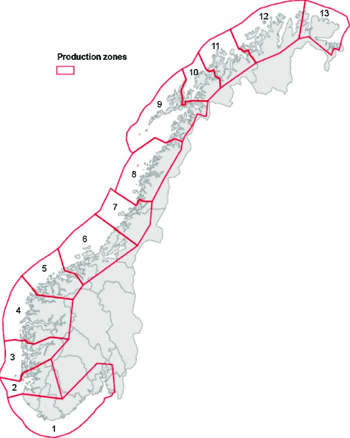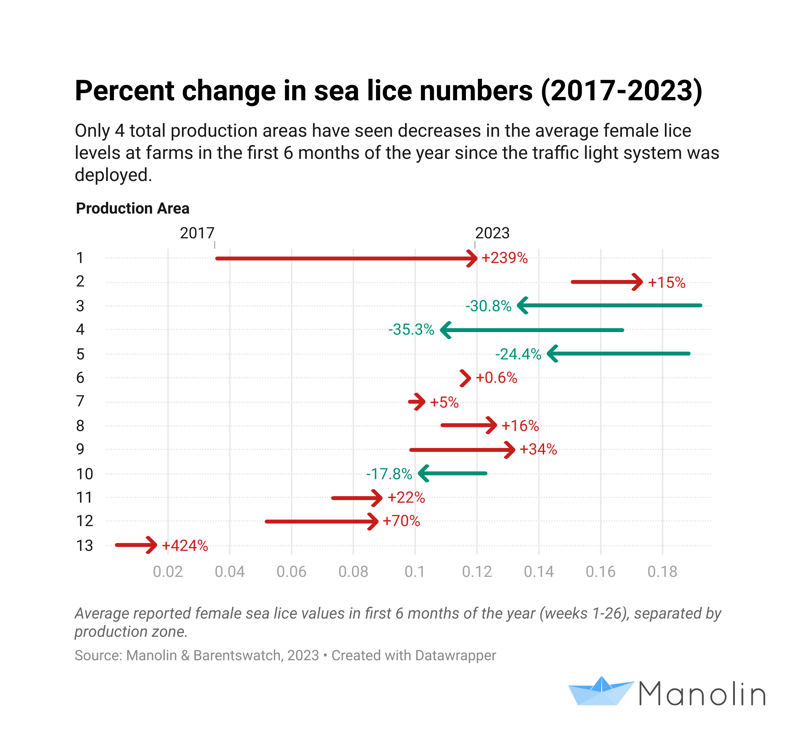Unmasking Sea Lice Insights: A Deeper Look at PO3 & PO4
 By
Manolin
·
3 minute read
By
Manolin
·
3 minute read
In light of NORCE's statements on the salmon lice situation in Norway's aquaculture production areas PO3 and PO4, a discussion has unfolded among farm leaders from these regions in response to their lice situation. Curious to gain deeper insights into this matter, our team at Manolin naturally delved into the data. Specifically, we wanted to investigate further and see if we could uncover further insights amidst the ongoing conversation surrounding these production areas and their relationship to the Norwegian traffic light system.
What is Norway's Traffic Light System for Aquaculture
For those who might be unfamiliar with Norway's traffic light system for aquaculture, lets first quickly review.
In 2017, Norway implemented the groundbreaking traffic light system to effectively manage its aquaculture industry. This system was put in place by the Norwegian government in response to the growing need for sustainable management of aquaculture and the protection of wild fish populations and the marine ecosystem. The system is evaluated and updated by the Norwegian Directorate of Fisheries, in collaboration with the Institute of Marine Research.
The traffic light system relies on a committee known as the Norwegian Coastal Administration, which evaluates and assesses the data for each zone. This committee closely monitors various indicators such as water quality, sea lice levels, and potential impacts on wild fish populations. Based on their assessments and findings, the committee determines the appropriate biomass and environmental conditions for each zone, subsequently updating the color designation of the zones accordingly.
The traffic light system employs a simple color-coding scheme with three categories: green, yellow, and red.
Green
Areas classified as green are considered environmentally favorable for aquaculture operations. They generally have good water quality and a low risk of negative impacts on wild fish populations. New licenses for fish farming can be granted in these areas.
Yellow
Yellow areas indicate a moderate risk level, and caution is required when establishing or expanding fish farms in these regions. Increased monitoring and mitigation measures may be necessary to minimize potential environmental impacts.
Red
Red areas represent high-risk zones where fish farming activities are restricted or prohibited altogether. These areas typically have poor water quality or are identified as important habitats for wild fish species. Fish farming operations may need to be reduced or phased out in these locations.
By employing this comprehensive system, Norway strives to strike a balance between the growth of the aquaculture industry and the preservation of the marine environment.

Quantitative risk assessment of salmon louse-induced mortality of seaward-migrating post-smolt Atlantic salmon - Scientific Figure on ResearchGate. Available from: https://www.researchgate.net/figure/Production-zones-1-13-along-the-Norwegian-coast_fig1_321472040 [accessed 12 Jul, 2023]
Common Arguments Against the Traffic Light System
Despite being recognized as one of the most intricate regulatory systems globally, the introduction of the traffic light system in Norway has not been immune to concerns. Several notable arguments raised against the system include:
- Questionable scientific basis: Experts have raised doubts about the system's ability to adequately consider factors affecting the transfer of sea lice from farmed salmon to wild salmon.
- Inflexibility: Fish farmers argue that the system lacks flexibility, preventing them from adapting their production practices to changing environmental conditions.
- Perceived unfairness: Some fish farmers believe that the system unfairly penalizes those who have taken measures to reduce sea lice levels.
- Accusations of protectionism: Critics argue that the system prioritizes the protection of the Norwegian wild salmon fishery over the salmon farming industry.
- Legal challenges: Several fish farming companies have challenged the system in court.
Diving Deeper into Norway's Sea Lice Numbers
Amidst the ongoing discussions surrounding PO3 and PO4, our team took the opportunity to examine sea lice data to get a clearer picture of these production areas' historical average totals.
In our analysis, we examined the female sea lice data spanning from 2017 to 2023, with a specific focus on weeks 1 to 26 of each year. We chose this timeline for a couple of significant reasons. First, it aligns with the period when farms initiate their strategic planning and preparation, starting as early as January, in order to comply with the mandated 0.2 female sea lice regulatory adjustment, which is applicable from weeks 16 to 22. Second, this timeframe coincides with the migration of wild salmon and trout, which typically occurs concurrently with the implementation of regulatory changes.
Based on data here's what we found.

What the Data Tells Us
The analysis of sea lice data has yielded fascinating insights. It is notable that out of all the production areas examined, only four have experienced a decline in average female sea lice levels. Remarkably, PO3 and PO4 have emerged as leaders in effectively reducing female sea lice levels since the implementation of the traffic light system.
These findings emphasize the value of how farms can leverage data intelligence to gain deeper insights into their farms and help enhance fish welfare management overall. By utilizing data intelligence, farms can establish a clearer understanding of their historical performance, compare it with industry benchmarks, and enhance transparency and insight into their fish health. This allows farms to not only monitor their current performance but also proactively improve their sea lice management practices, staying one step ahead. At Manolin, we are committed to providing data intelligence solutions to help production areas like PO3 and PO4, as well as others, effectively track and manage sea lice.

